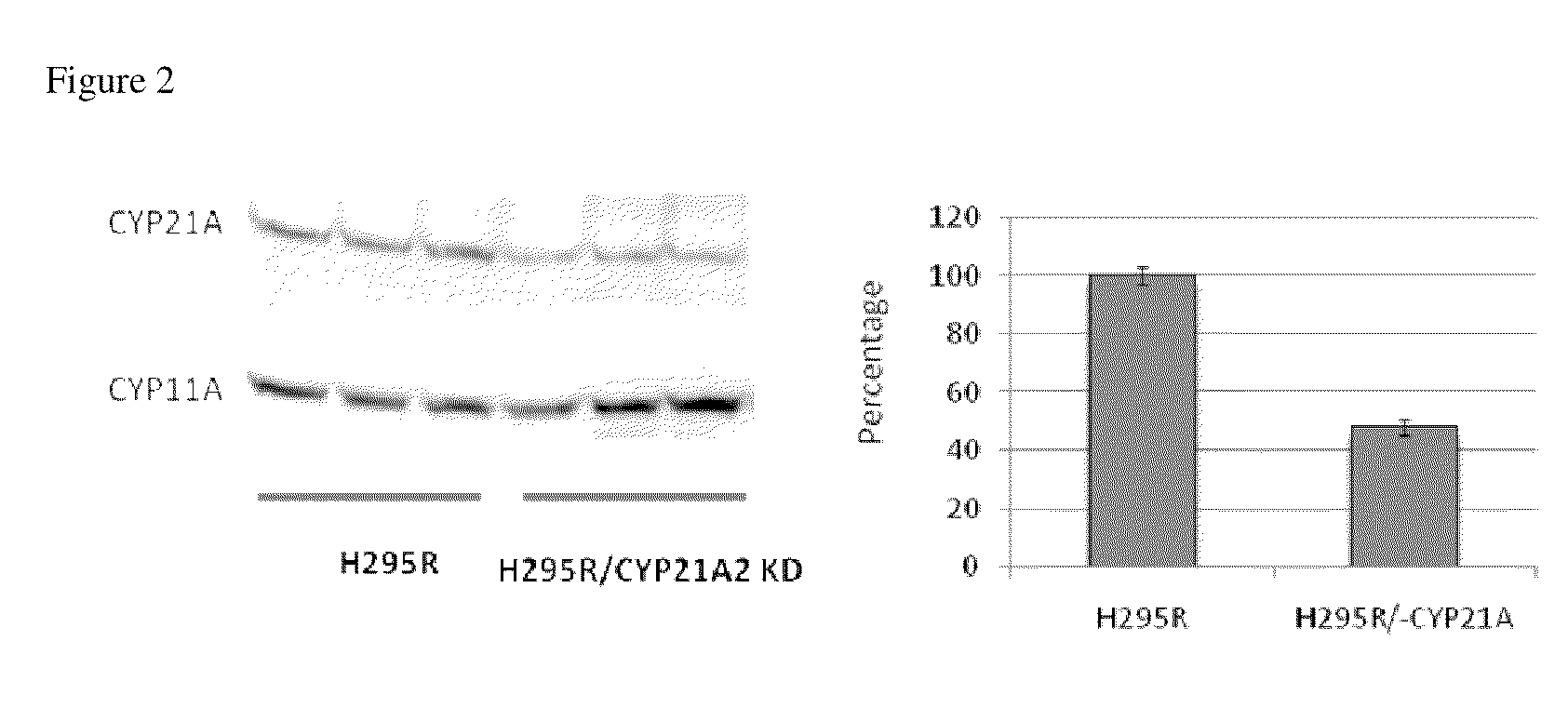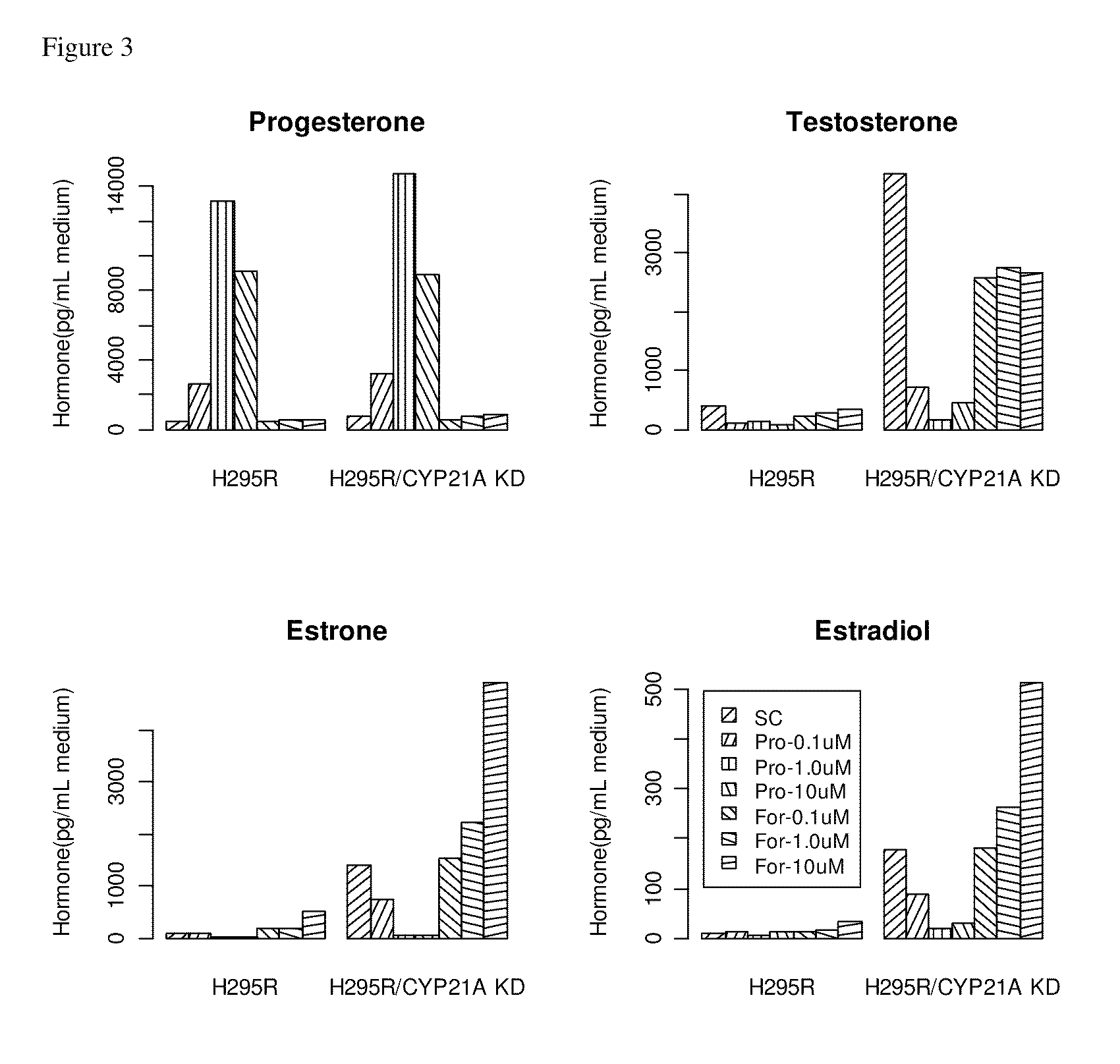Steroidogenesis modified cells and methods for screening for endocrine disrupting chemicals
a technology of endocrine disrupting chemicals and modified cells, applied in foreign genetic material cells, biochemistry apparatus and processes, sugar derivatives, etc., can solve the problems of difficult to demonstrate a decrease in production, difficult to measure the reduction of e2 release caused by edcs, and relatively large variance in e2 production around the detection limi
- Summary
- Abstract
- Description
- Claims
- Application Information
AI Technical Summary
Benefits of technology
Problems solved by technology
Method used
Image
Examples
example 1
[0213]A method to increase the accuracy and precision of the measurement of basal production of E2 as well as allow for greater sensitivity to detect the inhibitory effects of chemicals and to better discriminate among chemicals is needed. To achieve this goal two approaches were considered and applied. The first was to reduce the LOQ for ELISA and LC\MS-MS. While improvements in both methods have been achieved, the improvement was not deemed to be sufficient and the procedures were more time consuming. The alternative approach considered was to enhance the production of E2 released into the medium.
[0214]Progesterone and 17α-hydroxyprogesterone are the common precursors of mineralocorticoids, glucocorticoids, T and E2 (FIG. 1). Steroid 21-hydroxylase (CYP21) is an essential enzyme for the biosynthesis of mineralo- and glucocorticoids by converting progesterone and 17α-hydroxyprogesterone to 11-deoxycorticosterone (mineralocorticoid pathway) and 11-deoxycortisol (glucocorticoid pathw...
example 2
Gene Knock Downs of Other Enzymes Important for Steroidogenesis
[0231]The knock down cell lines listed in Table 1 were developed using the methods described in Example 1 to examine the gene knock-down on the production of different hormones, which can serve to assess EDCs and serve as models to simulate the enzyme inhibition by endocrine disrupting chemicals. The shRNA nucleic acids used to make these cell lines are listed in Table 2. The expected cell properties are listed in Table 5. Cell properties were confirmed for the CYP19A1 KD and the CYP17A1 KD. The CYP19A KD was confirmed with less production of Estrone (E1) which is a metabolite of estradiol suggesting E1 and E2 levels are reduced as predicted the CYP17A KD was confirmed with increased production of 21a hydroxyprogesterone and less production of 17 hydroxyprogesterone, androstenedione, testosterone and estrone, confirming increased production progesterone and decreased production of sex steroids as predicted.
[0232]These ce...
example 3
Multiple Gene Knockdowns
[0233]Similar methods to those described in Example 1 will be used to make steroidogenesis modified H295R cells with multiple gene knockdowns. The genes to be knocked down include for example, any two or more genes listed in Table 1. For transfection, cells are seeded onto 6-well plates and are transfected with single vector carrying multiple shRNA constructs for 5 h. After two d of culture, transfected cells are selected using culture medium containing 0.4 ug / mL puromycin (Sigma, St. Louis, Mo.) for an extended selection period (>3 weeks). Surviving cells are expanded and tested for production of various steroids.
[0234]As an example, H295R / CYP21A2&SULT1E1 knockdown cell aims to knockdown the protein expression of CYP21A2 and SULT1E1. SULT1E1 is a sulfotransferase enzyme which catalyzes the sulfate conjugation of estrogen. Simultaneous knockdown of both CYP21A2 and SULT1E1 can further raise the basal sexual steroid production and thereby increases the sensiti...
PUM
| Property | Measurement | Unit |
|---|---|---|
| Fraction | aaaaa | aaaaa |
| Fraction | aaaaa | aaaaa |
| Fraction | aaaaa | aaaaa |
Abstract
Description
Claims
Application Information
 Login to View More
Login to View More - R&D
- Intellectual Property
- Life Sciences
- Materials
- Tech Scout
- Unparalleled Data Quality
- Higher Quality Content
- 60% Fewer Hallucinations
Browse by: Latest US Patents, China's latest patents, Technical Efficacy Thesaurus, Application Domain, Technology Topic, Popular Technical Reports.
© 2025 PatSnap. All rights reserved.Legal|Privacy policy|Modern Slavery Act Transparency Statement|Sitemap|About US| Contact US: help@patsnap.com



